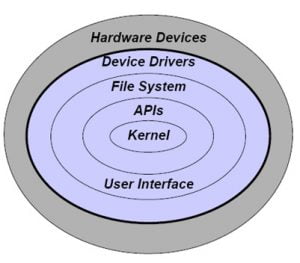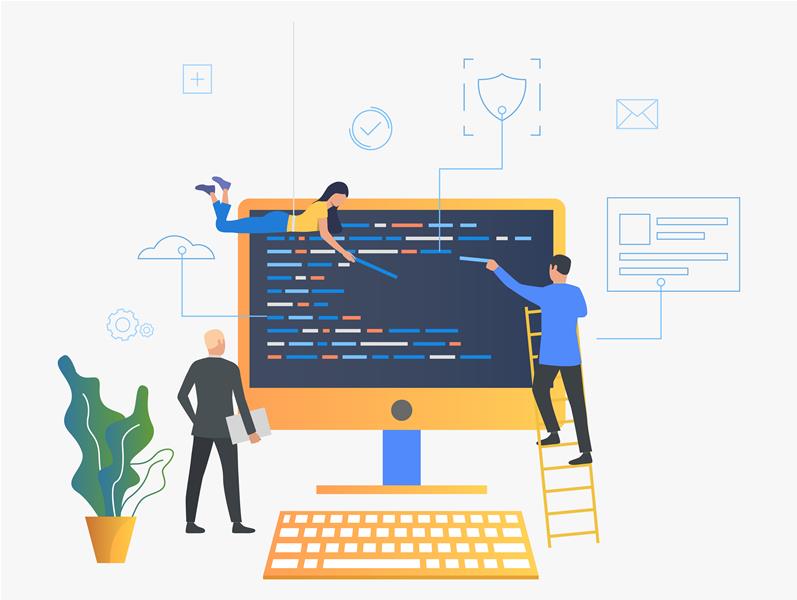
The term OS or operating system is a type of software and it works as an interface between the user and computer to perform all the tasks like memory management, file management, input & output handling, security, process management, Job accounting, error detecting, system performance controlling, peripheral devices controlling like printers & disk drives. The popular operating systems mainly include Windows, Linux, AIX, VMS, z/OS, etc. This article discusses an overview of what is an operating system and its components.
What is an Operating System (OS)?
Definition: An operating system can be defined as a system like a large & complex is partitioned into small pieces using an interface. This system is used to share the different OS components which include file, input/output device, process memory, etc. All the partitioned pieces must be well-defined parts of the system with carefully classified i/ps, o/ps & function. We know that all the systems don’t have a similar structure but several current operating systems share the components of the system outlined below.
The OS is the most significant program in a computer because every computer works with an operating system (OS) to run all the programs & applications. The main tasks of the computer OS are identifying i/p from the keyboard, sending o/p to the screen, tracking files, storage drives, peripheral devices controlling, like printers, etc.
Components of Operating System
The components of an operating system play a key role to make a variety of computer system parts work together. The operating components are discussed below.

Kernel
The kernel in the OS provides the basic level of control on all the computer peripherals. In the operating system, the kernel is an essential component that loads firstly and remains within the main memory. So that memory accessibility can be managed for the programs within the RAM, it creates the programs to get access from the hardware resources. It resets the operating states of the CPU for the best operation at all times.
Process Execution
The OS gives an interface between the hardware as well as an application program so that the program can connect through the hardware device by simply following procedures & principles configured into the OS. The program execution mainly includes a process created through an OS kernel that uses memory space as well as different types of other resources.
Interrupt
In the operating system, interrupts are essential because they give a reliable technique for the OS to communicate & react to their surroundings. An interrupt is nothing but one kind of signal between a device as well as a computer system otherwise from a program in the computer that requires the OS to leave and decide accurately what to do subsequently. Whenever an interrupt signal is received, then the hardware of the computer puts on hold automatically whatever computer program is running presently, keeps its status & runs a computer program which is connected previously with the interrupt.
Memory Management
The functionality of an OS is nothing but memory management which manages main memory & moves processes backward and forward between disk & main memory during implementation. This tracks each & every memory position; until it is assigned to some process otherwise it is open. It verifies how much memory can be allocated to processes and also makes a decision to know which process will obtain memory at what time. Whenever memory is unallocated, then it tracks correspondingly to update the status. Memory management work can be divided into three important groups like memory management of hardware, OS and application memory management.
Multitasking
It describes the working of several independent computer programs on a similar computer system. Multitasking in an OS allows an operator to execute one or more computer tasks at a time. Since many computers can perform one or two tasks at a time, usually this can be done with the help of time-sharing, where each program uses the time of a computer to execute.
Networking
Networking can be defined as when the processor interacts with each other through communication lines. The design of communication-network must consider routing, connection methods, safety, the problems of opinion & security.
Presently most of the operating systems maintain different networking techniques, hardware, & applications. This involves that computers that run on different operating systems could be included in a general network to share resources like data, computing, scanners, printers, which uses the connections of either wired otherwise wireless.
Security
If a computer has numerous individuals to allow the immediate process of various processes, then the many processes have to be protected from other activities. This system security mainly depends upon a variety of technologies that work effectively. Current operating systems give an entrée to a number of resources, which are obtainable to work the software on the system, and to external devices like networks by means of the kernel. The operating system should be capable of distinguishing between demands which have to be allowed for progressing & others that don’t need to be processed. Additionally, to permit or prohibit a security version, a computer system with a high level of protection also provides auditing options. So this will allow monitoring the requests from accessibility to resources
User Interface
A GUI or user interface (UI) is the part of an OS that permits an operator to get the information. A user interface based on text displays the text as well as its commands which are typed over a command line with the help of a keyboard.
The OS-based applications mainly provide a specific user interface for efficient communication. The main function of a user interface of an application is to get the inputs from the operator & to provide o/ps to the operator. But, the sorts of inputs received from the user interface as well as the o/p types offered by the user interface may change from application to application. The UI of any application can be classified into two types namely GUI (graphical UI) & CLI (command line user interface).
Thus, this is all about an overview of an operating system. The main components of an OS mainly include kernel, API or application program interface, user interface & file system, hardware devices and device drivers. Here is a question for you, what are the different types of an OS?
[“source=elprocus”]





